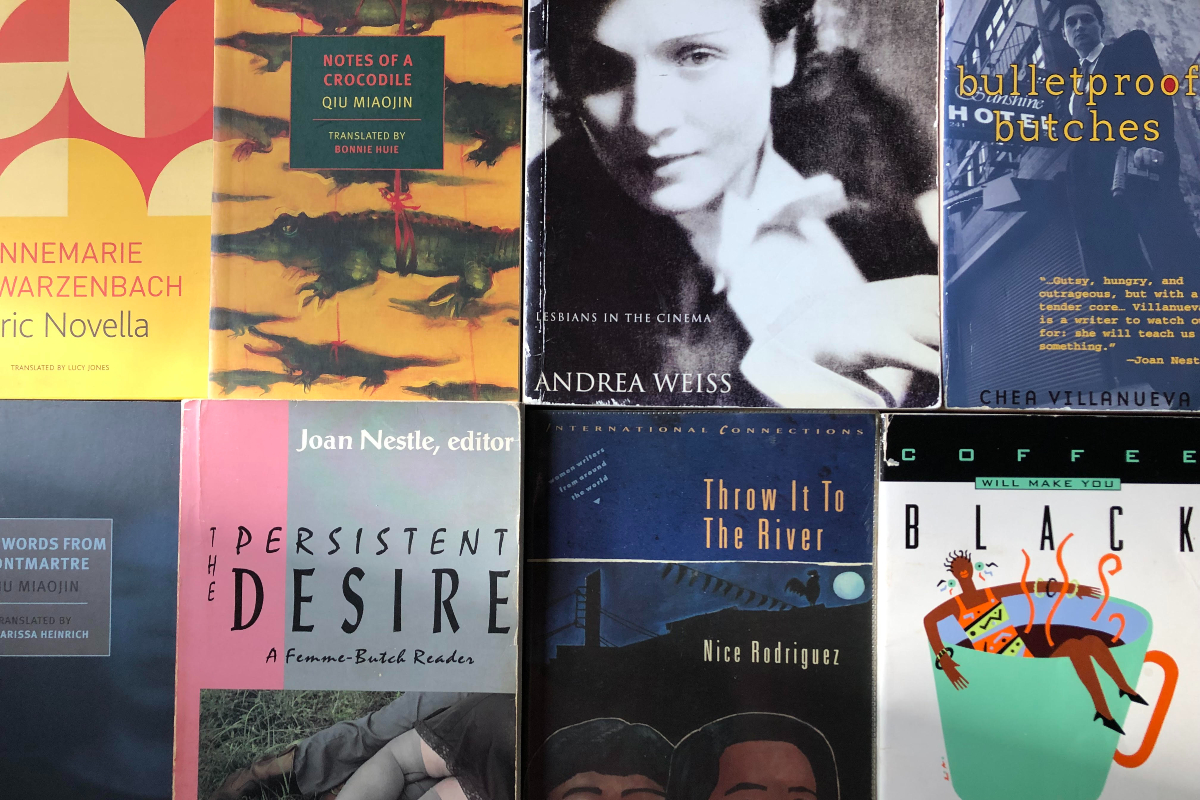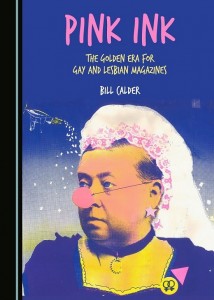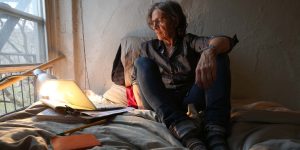Out of print: Lesbian literature as an artefact of queer history
By: Darla Tejada

Just like many introverted and bookish dykes, the first place I turned to when I was coming to terms with my lesbianism was books.
Although I’m grateful that I don’t live during a time when the only available lesbian representation involves the lesbian dying at the end or ending up with a man – I’m looking at you, Radclyffe Hall – I still found myself looking back through the pages of history.
Image: A sample of Darla’s collection of lesbian literature (courtesy of the author)
I grew up in a Catholic household within a conservative Asian society (the Philippines and then Singapore), and attended deeply religious schools. In these settings, sexuality was never discussed. Homophobia was the norm. I didn’t feel safe to even ask questions about lesbians.
Then the COVID-19 pandemic hit, and I felt more isolated than ever. I needed to know that I had a community out there, and I wanted to learn how they sought each other, even when they were forced to hide. I was interested to learn about the spaces that queer people created for themselves because they were shunned elsewhere.
And so, I took refuge in the archives of lesbian literature which – at the time – felt like the only way I could connect to my community and their history.
After completing the rite of passage of reading Stone Butch Blues, I became fascinated by the role of lesbian bars as a refuge within the queer community at large. I craved more fiction set in the bars and written by authors who experienced their heyday.
The Bar Stories, Nisa Donnelly’s out-of-print novel and winner of the Lambda Literary Award for Lesbian Fiction in 1990, follows the colourful patrons of Babe’s Bar in San Francisco. Donnelly taught me that lesbian bars were not just a place to find romantic love and/or sex (although they certainly served that purpose too), but these venues were the nucleus of the lesbian community.
The Bar Stories showed that lesbian was not a monolith: not in terms of politics, class, background and not even in how we love. Donnelly triumphed in showing the minutiae and the individuality that is never afforded to people grouped by society according to an arbitrary characteristic – like sexuality – simply because it deviates from the ‘norm’. Despite these differences, Donnelly captured how we built a refuge for and with each other.
I am not surprised that The Bar Stories is out of print. It is a book doubly penalised for its queerness and the genders of its protagonists. The Bar Stories is explicitly and unapologetically lesbian, and queer literature not written by white men rarely becomes mainstream, much less becomes canonised. Nevertheless, this book captured a moment of lesbian history.
After finishing The Bar Stories, I thought it necessary to educate myself on butch/femme culture because it was an inextricable and integral part of lesbian history.
Even within queer media and history, butch/femme culture is overlooked. I wanted to read about butch and femme experiences, and to educate myself on their contributions to the lesbian and queer communities at large. Butch people are also incredibly attractive, and I wanted to know as much about them as I could.
The Persistent Desire (1992) is a compendium of butch/femme history through personal accounts, poetry, short stories and socio-political theory. Notoriously scarce (and expensive), I was initially content with borrowing it from my university library.
When the library copy arrived and I held it in my hands, I was overwhelmed by the experience of handling an artefact of lesbian history. Here was tangible proof of lesbians coming together and accomplishing the task of writing down their history, despite the shame they were made to feel, and the oppression they were constantly and vehemently subjected to.
To me, The Persistent Desire as an object symbolises how its contributors have finally and enduringly taken up the physical space that was so often denied to them. The physicality of this book renders lesbians and their place in history visible.
I was overcome with the desire to acquire my own copy. Not just as a reminder that I, and people like me, deserve to exist, but also to preserve these artefacts of lesbian history so they can be passed on to the people who will come after.
I bought my copy of The Persistent Desire second-hand from a seller in France. Upon receiving it, I found that it belonged to Tracey C., who lived in England (their address was included alongside their name). I wrote my name beside Tracey’s, who I like to imagine was a lesbian too. Regardless, I hope they found as much hope and solace in The Persistent Desire as I did.
Despite the publishing industry’s growing inclusivity, books that are by and about individuals at the intersections of marginalised identities are still rare. Their scarcity prompted me to explore the archives of forgotten lesbian literature.
Published in 1992, Nice Rodriguez’s Throw it to the River – a short story collection all following Filipinx lesbians – is considered “the first Filipino lesbian” book. Reading this book at 23 was the first time I saw myself wholly represented in fiction.
It’s an isolating experience to never see anyone like yourself in the media. Though I knew logically that there were other Filipinx lesbians out there, the lack of representation still made me feel othered, both in the queer and Filipinx communities. I needed a physical copy – not just because it wasn’t available as an eBook, but to remind myself that stories and experiences like mine deserve to take up space and to be preserved.
Books like Throw it to the River and Chea Villanueva’s Bulletproof Butches – an out-of-print Filipinx lesbian novel from 1997 – are often published by small independent presses. While independent publishers champion a diverse literary ecosystem (and are therefore the best!), having smaller funds and fewer resources hampers the accessibility and circulation of these books.
Furthermore, historical lesbian texts are often taken out of print due to being ‘unrelatable’. This has made me even more determined to keep their legacy alive. I want to read and remember lesbian literature in the way it deserves, even if no one else does.
My collection of obscure lesbian books is growing. Coffee Will Make You Black by April Sinclair, Last Words from Montmartre by Qiu Miaojin and Lyric Novella by Annemarie Schwarzenbach are just some of the forgotten lesbian classics that I feel deserve to be read by a larger and a more contemporary audience. I truly could go on, but I can’t keep you here for long.
Often, I wonder what will become of them if I meet an untimely demise. Would I want to donate them to an academic institution? Will they end up in someone else’s personal collection?
All I know is that I intend to keep (and read) them for as long as I can, and hope that their next reader will do the same.
Darla Tejada is a graduate of Maths who has always had a passion for literature. She loves reading obscure books by BIPOC and/or queer authors. She has lived in 3 countries but is currently based in Naarm. You can find her on Instagram @11dgabriellet11.













